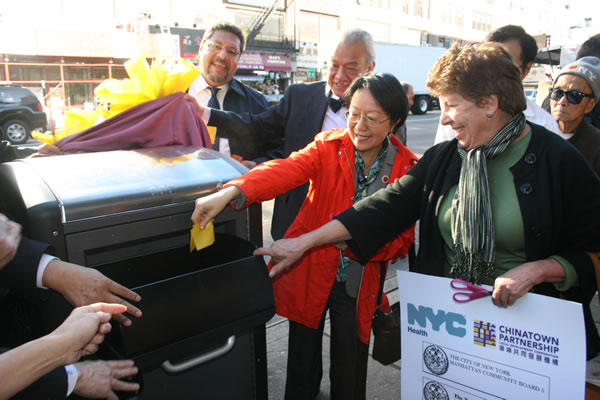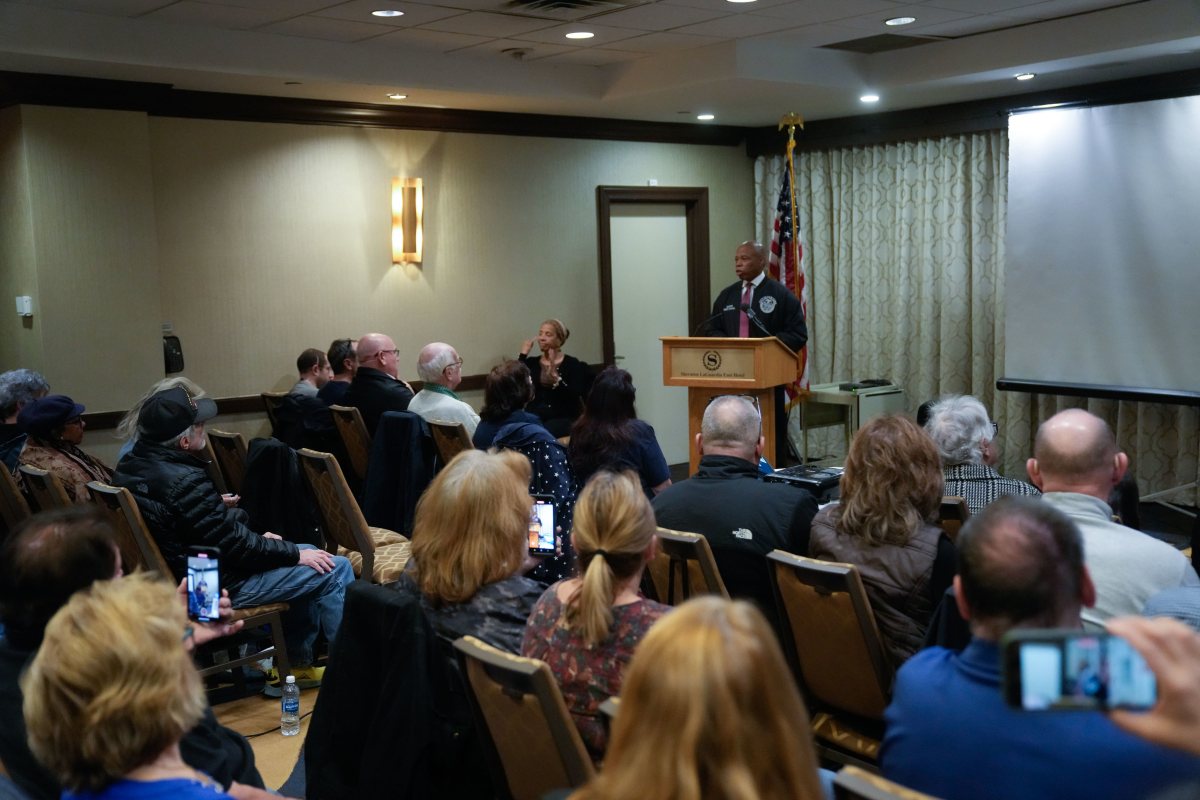By Aline Reynolds
A high-tech garbage collection method has been introduced in Chinatown and Tompkins Square Park — which definitely can use it, since they’re located in one of Manhattan’s most rodent-infested districts.
The Chinatown Partnership Local Development Corporation, sponsor of the neighborhood’s forthcoming business improvement district, has partnered with Direct Environmental Corp. (DEC Green) to install a solar-powered, digitalized trash compactor at the southeast corner of Canal and Mott Sts.
Community leaders along with Councilmember Margaret Chin and others gathered at the Chinatown intersection on Wed., Nov. 9, to unveil the pilot compactor, dubbed, “BigBelly,” which holds five times the amount of garbage as a traditional trash receptacle and can reduce trash collection by 80 percent. The Chinatown BigBelly will join the two dozen or so others dispersed around Manhattan.
“The aim is to explore its potential usefulness for the Chinatown BID area,” said Wellington Chen, executive director of the Chinatown Partnership. The BID’s sanitation committee, which will be formed in the new year, will determine which other intersections would benefit from the compactor.
“Certain locations require traditional garbage cans for traffic and a variety of other reasons,” said Chen. “We’re going to be very selective if we do implement it by first testing it out.”
Containing a computer and a smartphone, the compactor connects wirelessly to the company BigBelly Solar’s headquarters in Massachusetts. The Web-based system is set up so that the BigBelly automatically tracks its own garbage load in real time.
“It will report to a Web-based program and let you know when it’s full and needs to be changed,” said Franklin Cruz, chairperson of the Bronx-based D.E.C. Green, which is responsible for manufacturing New York State’s BigBellies.
By applying 1,250 pounds of pressure, Cruz explained, the BigBelly crushes accumulating litter, clearing the way for more trash to be added to the container.
“Toward the top of the internal bin is a laser, which sends an impulse to the computer notifying it of any obstructions,” he added.
While celebrating the BigBelly’s installation at the corner of Canal and Mott last week, Chin proudly labeled the compactor the “garbage can of the future.”
“I’m so glad that Chinatown is taking this major step in collecting garbage and keeping our community clean,” said the councilmember, who remarked on the compact size of the BigBelly — comparing it to an earlier, larger version she had seen in Flushing, Queens.
“I can’t believe I’m so excited about a garbage can!” said Susan Stetzer, Community Board 3’s district manager, who led off the press conference. “This is a perfect example of why you need the BID. Who else is going to sponsor this?” she said of the Chinatown BID.
Indeed, BigBelly solar cans were placed in Union Square Park two and a half years ago by the Union Square Partnership BID.
While the mechized cans are a pricey $4,000 a piece, they can result in hefty overall savings for municipalities, according to Cruz. Now outfitted with about 1,000 BigBellies, Philadelphia, for example, has pared down its trash collection from 17 times a week to twice a week, leading to ciytwide cost reductions in sanitation of nearly $1 million, according to Cruz.
Apart from economic waste, premature trash collection and landfill dumping have an adverse impact on the environment, Cruz argued.
“This will delay the need for garbage pickups, save on car fuel and wear and tear on the roads, and dramatically reduce carbon emissions,” he said, adding, “The point of collection is where you can make a difference.”
The relatively new trash collection technology doesn’t have to result in layoffs of sanitation workers, either, Cruz assured: In Philadelphia’s case, sanitation personnel were transferred to the city’s recycling program, which was enhanced following the BigBelly installations.
The BigBellies have proven virtually indestructible. They weigh more than 300 pounds and are made of recycled car bumpers and polycarbonate — making them resistant to extreme temperatures and any kind of weather. One BigBelly was even unharmed after being submerged in water in Port Jefferson, Long Island, during Hurricane Irene, according to Cruz.
“I’ve been a distributor and assembler of the product since 2007, and I can count on the fingers of one hand how many service calls I’ve gotten,” he saids.
Nonetheless, Cruz recommends the compactors be fastened to the ground for safety reasons.
“It’s possible that you could have people who just for fun want to see if they could knock it over into the street,” he noted.
And, while they’re not so big so as to lend themselves to being used for dumping pets or other living things, Cruz admitted that such destructive behavior is, unfortunately, possible.
“I can’t speak for the public,” he said. “If somebody wanted to put something in there, I guess they could.”
Chinatown community members welcomed the futuristic wastebasket into their neighborhood.
“A lot of people think we’re a futile society and do it the old way with a broomstick,” said Chen. “This is a more innovative way to say there are greener, possible hybrid solutions to what we’re trying to tackle here.”
“And more importantly, Ratatouille cannot get inside!” said Chen, referring to Remy, the fictional rat in the 2007 computer-animated film, “Ratatouille.”
Studies have indeed shown that the BigBellies are impervious to rodents and help to curb rodent infestations, Cruz said. Following a pilot program in which three BigBellies supplanted traditional wastebaskets in Thomas Paine Park — north of Foley Square — from April to October this year, urban rodentologist Robert Corrigan, a city Health Department employee, reported a migration of the rats away from the park.
An endless supply of litter that accumulates in public trash bins allows the rats to “flourish,” according to Cruz.
“Corrigan’s theory is that, the reason why the rat population is so difficult to control, particularly in New York, is because it’s very difficult for sanitation to keep up with emptying trash baskets,” said Cruz. “So, if we could eliminate the food source and continue to bait, there might be some progress made in the fight against the rats in New York City.”
Corrigan could not be reached for comment by press time.
C.B. 3, a strong supporter of rat-proof garbage cans, has the second-worst rat problem of all of Manhattan’s 12 community boards, topped only by Washington Heights, according to Stetzer, who helped secure three pilot BigBellies for Tompkins Square Park. The high-tech receptacles were installed in the East Village park early last month, Cruz said, and will stay there for at least a year.
Asked why it took so long for C.B. 3 to adopt the BigBelly program, Stetzer replied, “It’s a culture thing. It’s really hard to get change in New York City.”





































